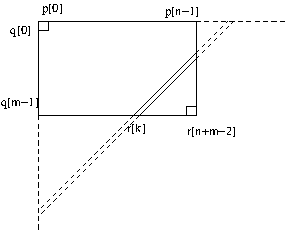
Sometimes, recursive decomposition can be done more efficiently in a way in which the parts are not straightforward, but reduce the number of operations.
Basic example of such decomposition: compute a complex product by using only 3 (instead of 4) real multiplications).
Solution: (a+bi)*(c+di) = (ac-bd) + (ad+bc)i = (ac-bd) + (ac+ad+bc+bd-ac-bd)i = (ac-bd) + ((a+b)*(c+d) - ac - bd)i, which can be computed using only 3 real multiplications (but more additions/substractions).
Polynomial multiplication using Karatsuba algorithm
Note: for the classical algorithm, computing the coefficients leads to computing the products and then add diagonals in the following table:

Idea:
Assume input polynomials P(X) and Q(X) of degree 2*n-1.
Write them as P(X) = P1(X)*X^n+P2(X) and Q(X) = Q1(X)*X^n+Q2(X).
Now P(X)*Q(X) = (P1(X)*X^n+P2(X)) * (Q1(X)*X^n+Q2(X)) =
= P1(X)* Q1(X)*X^2n +
(P1(X)*Q2(X)+P2(X)*Q1(X))*X^n +
P2(X)*Q2(X)
But the second term can be written as
(P1(X)+P2(X)) * (Q1(X)+Q2(X))
- 1(X)* Q1(X) - P2(X)*Q2(X)